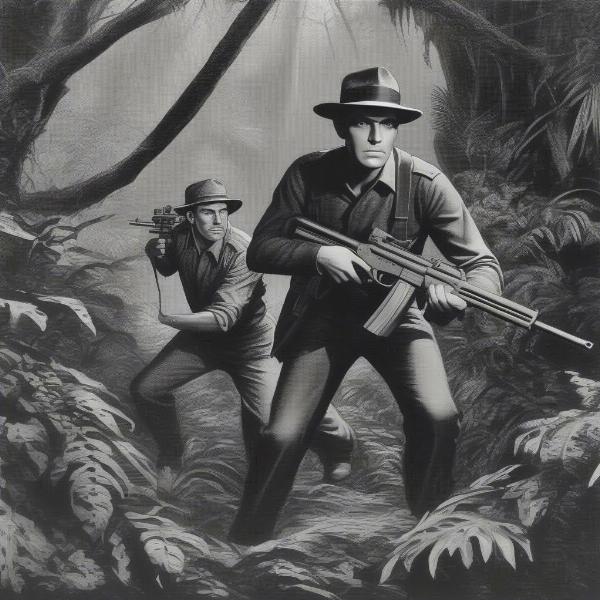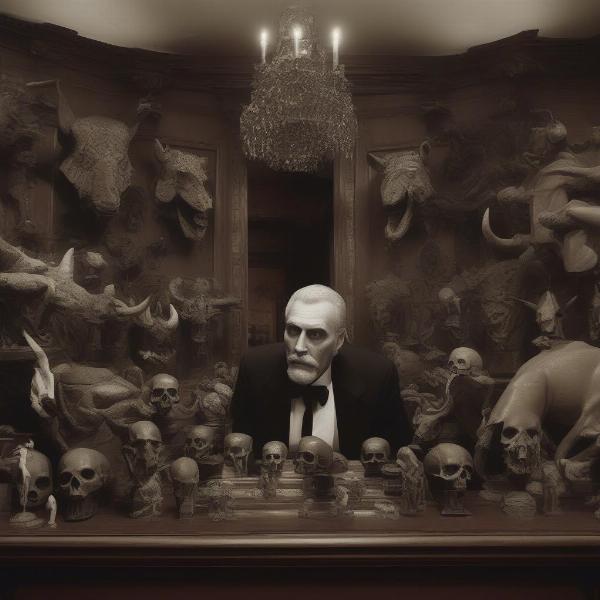The conflict in Richard Connell’s “The Most Dangerous Game” is multifaceted and thrilling, revolving around the clash between Rainsford and General Zaroff. This conflict centers on the contrasting philosophies of the two hunters and the terrifying game Zaroff has devised. Let’s dive deep into the heart of this classic tale and explore the layers of conflict that make it so enduring.
The Hunter vs. The Hunted: A Primal Struggle
At the core of “The Most Dangerous Game” lies the immediate, visceral conflict of hunter versus hunted. Rainsford, a renowned big-game hunter, initially holds a traditional view of hunting. He sees animals as prey without higher reasoning or emotional capacity. This perspective shifts dramatically when he becomes Zaroff’s quarry. Forced to outwit the general, Rainsford experiences the terror and desperation of being hunted, challenging his own beliefs about the nature of hunting and the value of human life. This reversal of roles creates a compelling dynamic, forcing Rainsford to utilize his hunting skills not for sport, but for survival.
Rainsford’s transformation from hunter to hunted is central to the story’s exploration of morality and the ethics of hunting. As he fights to survive, he is forced to confront the implications of his own actions and the dehumanizing nature of Zaroff’s game. This conflict highlights the thin line between the thrill of the chase and the respect for life.
 Rainsford and Zaroff in a Tense Standoff
Rainsford and Zaroff in a Tense Standoff
The Clash of Philosophies: Reason vs. Instinct
Beyond the physical hunt, a philosophical conflict brews between Rainsford and Zaroff. Zaroff, bored with hunting ordinary animals, has elevated his pursuit to the ultimate prey: humans. He argues that humans, with their capacity for reason, present a more challenging and stimulating hunt. This belief directly clashes with Rainsford’s evolving perspective. As he becomes the hunted, Rainsford comes to understand the profound value of human life and the inherent cruelty in Zaroff’s game. This philosophical clash forms the intellectual heart of the story, raising questions about the nature of humanity, the limits of reason, and the justification of violence.
The contrasting philosophies of the two hunters represent the core ideological conflict. Zaroff’s belief in the superiority of reason as a justification for his hunting humans is countered by Rainsford’s eventual realization of the sanctity of human life, regardless of intellectual capacity. This battle of ideals elevates the story beyond a simple chase, adding layers of moral complexity.
 Visual Representation of Zaroff's Twisted Philosophy on Hunting
Visual Representation of Zaroff's Twisted Philosophy on Hunting
Internal Conflict: Rainsford’s Moral Dilemma
“The Most Dangerous Game” also delves into Rainsford’s internal conflict. Initially, he is a seasoned hunter who views hunting as a sport. However, as he becomes the prey, he grapples with the moral implications of his previous beliefs. He is forced to question the ethics of hunting, the value of human life, and the boundaries of acceptable behavior. This internal struggle transforms Rainsford from a detached sportsman into a man fighting for his survival and grappling with the fundamental principles of right and wrong. This internal conflict adds depth to the narrative, making Rainsford a more complex and relatable character.
Rainsford’s internal struggle represents the humanizing element of the narrative. His initial confidence and detached perspective on hunting is shattered as he becomes the hunted, forcing him to confront his own morality and the potential for cruelty within himself. This internal conflict adds a layer of psychological depth to the story.
The Island Setting: Isolation and Fear
The isolated island setting of Ship-Trap Island contributes significantly to the conflict. The island’s remoteness and ominous reputation create an atmosphere of suspense and fear, intensifying the psychological pressure on Rainsford. The jungle environment, with its dense foliage and treacherous terrain, becomes both a refuge and a prison for Rainsford, adding another layer of challenge to his struggle for survival. The isolation of the island intensifies the conflict, emphasizing the power dynamic between Zaroff and Rainsford and the lack of external intervention.
The isolated setting amplifies the sense of danger and vulnerability, trapping Rainsford in a deadly game with no escape and highlighting the primal nature of the conflict. This isolation contributes to the psychological tension and adds to the overall suspense of the narrative.
 The Isolation of Ship-Trap Island
The Isolation of Ship-Trap Island
Beyond the Hunt: Exploring Deeper Themes
The conflict in “The Most Dangerous Game” transcends the simple hunt, touching upon broader themes of civilization versus savagery, reason versus instinct, and the ethics of hunting. The story prompts readers to question the boundaries of human behavior and the consequences of unchecked power.
What Drives Zaroff’s Obsession?
General Zaroff’s obsession with hunting humans stems from his boredom with traditional hunting and his belief in the superiority of humans as prey due to their capacity for reason. This twisted logic drives the central conflict of the story.
How Does Rainsford Ultimately Triumph?
Rainsford’s eventual triumph over Zaroff comes from his ability to adapt, utilize his hunting skills for survival, and exploit Zaroff’s overconfidence. This demonstrates the resilience of the human spirit and the importance of resourcefulness in the face of adversity.
What is the Significance of the Island Setting?
The isolated island setting of Ship-Trap Island enhances the sense of danger and vulnerability, emphasizing the power imbalance between Zaroff and Rainsford. This isolation contributes significantly to the psychological tension of the narrative.
Conclusion
“The Most Dangerous Game” presents a complex and engaging conflict that extends beyond a simple hunt. The clash between Rainsford and Zaroff explores deeper themes of morality, reason, and the primal nature of survival. The story’s enduring popularity lies in its ability to provoke thought and discussion about the human condition and the boundaries of acceptable behavior. What do you think drives the conflict in “The Most Dangerous Game”? Share your thoughts in the comments below!

